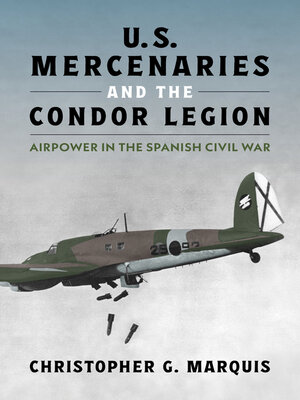U.S. Mercenaries and the Condor Legion
ebook ∣ Airpower in the Spanish Civil War · History of Military Aviation
By Christopher G. Marquis

Sign up to save your library
With an OverDrive account, you can save your favorite libraries for at-a-glance information about availability. Find out more about OverDrive accounts.
Find this title in Libby, the library reading app by OverDrive.



Search for a digital library with this title
Title found at these libraries:
| Library Name | Distance |
|---|---|
| Loading... |
American military attachés document the impact of airpower during the Spanish Civil War, featuring intervention by some of the strongest air forces in the world in a prelude to World War II.
This is the story of airpower in the Spanish Civil War from the perspective of three key American figures: Colonel Stephen Fuqua, military attaché to Republican Spain; Captain Townsend Griffiss, assistant military attaché for air; and former U.S. Navy pilot Frank Tinker, who flew for the Spanish government as a mercenary. Through his analysis of the experiences and writings of these three individuals, author Christopher Marquis explores the lessons the conflict revealed regarding the use of airpower in war.
The book first places the Spanish Civil War within the broader context of early U.S. airpower development, progressing through the narrative of the war while focusing on key air operations and technological advancements. Marquis begins with the early history of American airpower through World War I and the institutional development of the U.S. Army Air Service and U.S. Army Air Corps. He also covers the evolution of early airpower theories, particularly the idea of strategic bombing, which involved the bombardment of civil, industrial, and political targets to bring the war to a swift conclusion.
The narrative then moves to Spain in July 1936 and follows the course of the civil war, with a focus on air operations. Some of the significant events covered in detail include the airlift of Nationalist troops from Morocco to Spain; defensive counterair missions above Madrid; the firebombing of Guernica; the destruction of the "Iron Ring" of fortifications around Bilbao; the bombing of Barcelona; and, finally, the air superiority achieved by the Nationalist air force and their allies. The U.S. observers witnessed the German Luftwaffe's intervention in the conflict as well as air forces from Italy, France, and the Soviet Union.
Marquis concludes that the Spanish Civil War proved airpower was a critical element of modern warfare. He also points out that American airpower leaders were reluctant to acknowledge the lessons of the war because they did not definitively prove the effectiveness of strategic bombing. Despite that reluctance, America's subsequent actions in developing its aircraft inventory before World War II reflected some of the lessons learned from the air war in Spain.







